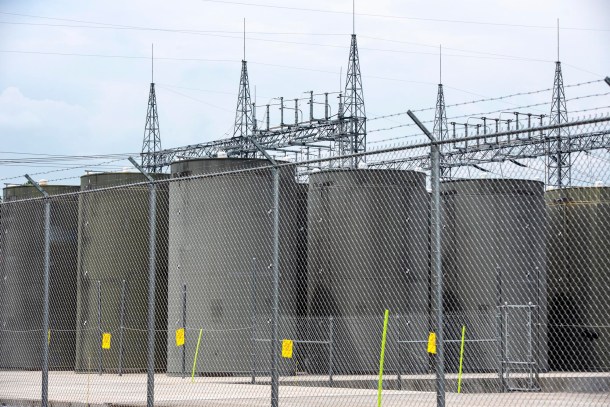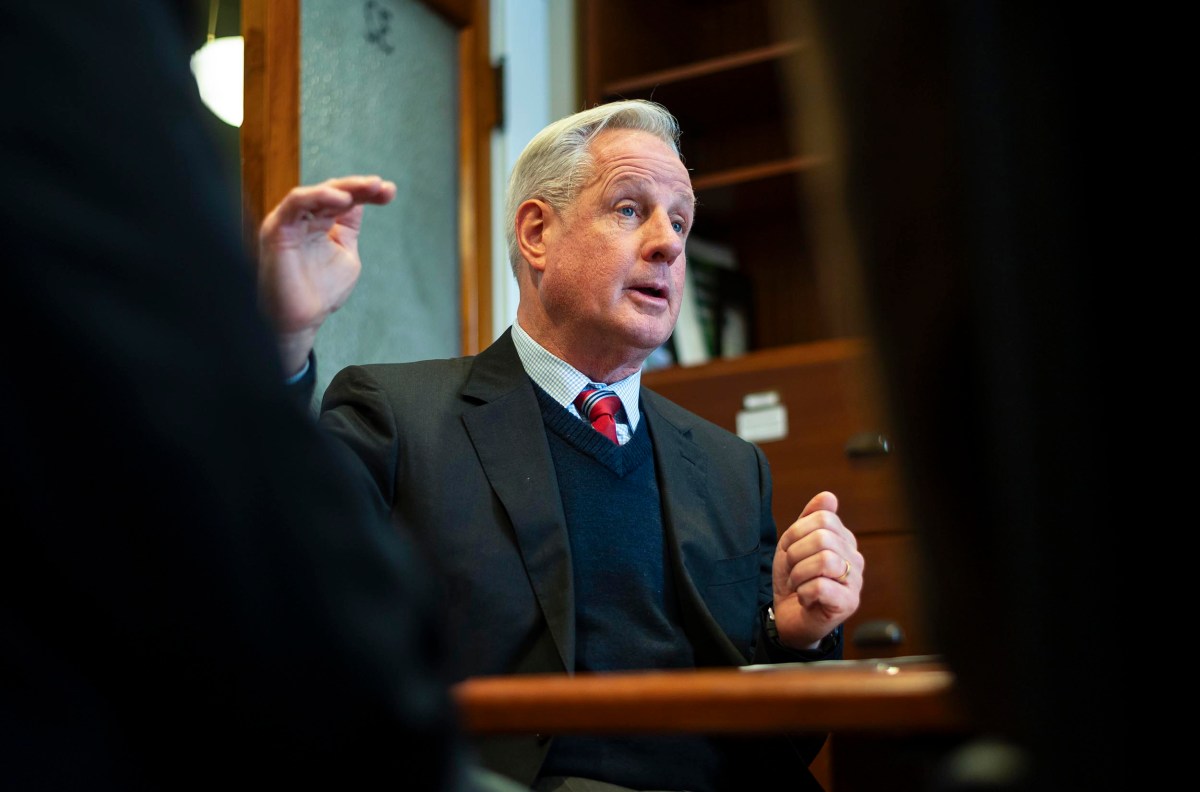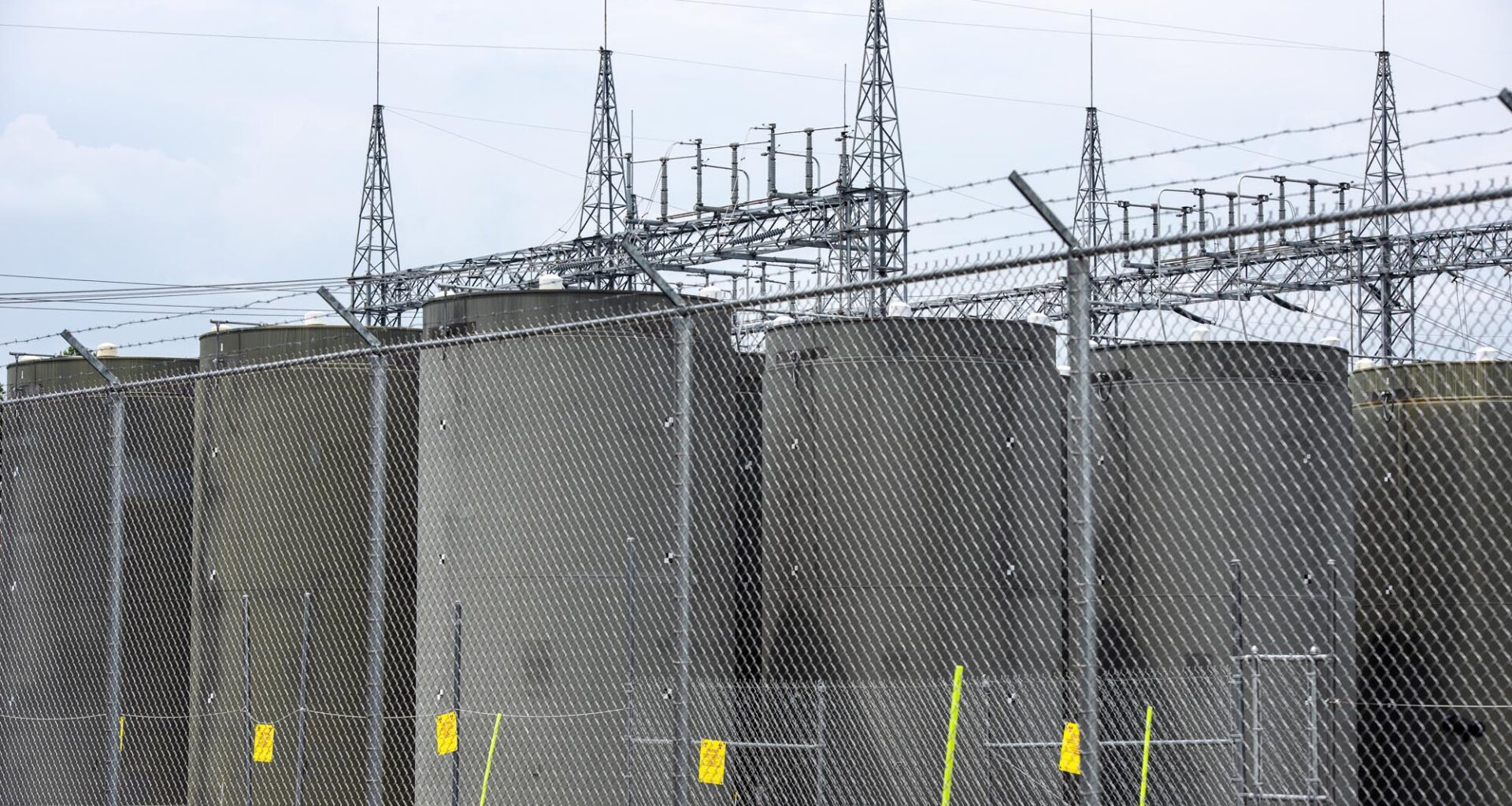 Spent nuclear fuel casks are stored at the Vermont Yankee nuclear power plant in Vernon on July 11, 2019. File photo by Glenn Russell/VTDigger
Spent nuclear fuel casks are stored at the Vermont Yankee nuclear power plant in Vernon on July 11, 2019. File photo by Glenn Russell/VTDiggerLast month, Gov. Scott slipped a subtle mention of plans to explore new nuclear energy production in a low-key social media post that has so far drawn little attention from the public and lawmakers.
In the March 21 post on X, Scott expressed some familiar talking points: Vermont and New England’s electricity prices are “much too high,” and the path to establishing a low-carbon energy portfolio is a long one. But, in the thread, Scott introduced a new idea that he’s been exploring with other New England governors — new nuclear technology called small modular reactors.
The reactors are smaller, easier-to-assemble nuclear facilities that are slowly gaining international interest, especially as President Donald Trump pursues policies that would make renewable sources and Canadian hydropower more expensive. The consideration is another facet of the Vermont governor’s push to get the state to include nuclear in its long term transition off fossil fuels.
The discussions with other states are little more than early stage at this point, on whether the technology would be a viable way to meet New England’s energy needs without passing surging costs on to consumers, said Kerrick Johnson, commissioner of the Vermont Department of Public Service. The considerations are still so preliminary, he described them as “pre initial” conversations.
“The thought was, being mindful of concerns for greenhouse gas emissions, what’s an affordable way that broadens our options to continue to reach our climate goals while achieving affordability?” Johnson said.
A number of significant barriers stand in the way of those conversations becoming anything concrete.
For starters, Vermont’s Renewable Energy Standard requires the majority of the state’s utilities to source 100% of their electricity from renewable sources by 2030 and all utilities to do so by 2035. But the law explicitly excludes nuclear fuel from its definition of renewable energy. The Scott administration hopes to change that framework to one that includes nuclear energy, as outlined in an omnibus climate bill introduced in February, but the bill has so far seen little traction in the Democratic-led legislature.
Another big obstacle: the technology is still in its infancy. Currently, only two operational small modular reactors exist in the entire world, and though many sites in the U.S. have plans to bring more online in the next decade, the supply chains to build the facilities at a wider (and cost-effective) scale, simply don’t exist yet.
Yet, the Trump administration’s threat of tariffs and what it’s already done to “fundamentally undermine” the U.S.’s relationship with Canada has led New England to look elsewhere for energy, Johnson said. Roughly half of the renewable energy purchased or generated by Vermont’s utilities is hydropower, and most of that comes from HydroQuebec.
On top of that, offshore wind, which many distribution utilities were considering as a key source of renewable energy, now “essentially is off the table,” as the Trump administration pauses and revokes permits for the technology, Johnson explained.
“When you take the logical, policy-aligned resources off the table — which is where we are right now — where do you look for resources to keep the lights on?” Johnson said. Thus, the thought of small nuclear reactors grew more inviting.
 Department of Public Serivce Commissioner Kerrick Johnson testifies on the possible impact of President Trump’s tariffs on the state’s energy prices before the House Energy and Digital Infrastructure Committee at the Statehouse in Montpelier on Tuesday, February 4. Photo by Glenn Russell/VTDigger‘Like Legos’
Department of Public Serivce Commissioner Kerrick Johnson testifies on the possible impact of President Trump’s tariffs on the state’s energy prices before the House Energy and Digital Infrastructure Committee at the Statehouse in Montpelier on Tuesday, February 4. Photo by Glenn Russell/VTDigger‘Like Legos’
Interest in small modular reactors is a growing trend, one that advocates see as helping meet globally growing energy demand and the massive electricity needs of AI data centers, without relying on fossil fuels.
The facilities are smaller than traditional nuclear reactors — producing around 300 megawatts of energy. A conventional nuclear reactor produces between 700 and 1200 megawatts. The Vermont Yankee reactor in Vernon produced 650 megawatts before it went offline and started the process of decommissioning, and the Seabrook power plant in New Hampshire, where Vermont still buys around 18% of its energy, produces over 1200 megawatts. The small units need to refuel every 3-7 years, rather than every 1-2 years like conventional plants.
The risk to surrounding communities in the event of an accident is also smaller than the risk larger reactors pose, said Koroush Shirvan, a professor of energy studies specializing in small modular reactors at the Massachusetts Institute of Technology. The amount of power produced is “proportional to the amount of radioactive material that can get out,” he said.
The small reactors are also considered safer because they can rely on automatic responses to shut down systems, rather than on a human or external cue to shut down, according to an explainer published by the International Energy Agency.
And, as the name also suggests, they are modular units, made of prefabricated parts that can be assembled on site, which should make their construction easier and cheaper in the long run. “Like Legos,” Shirvan said.
Developers are testing a similar modular approach to building large nuclear facilities in the U.S., Shirvan said, but the high upfront costs for the larger projects — as well as the safety risks — are driving more interest in the smaller models.
Shirvan said he sees the smaller reactors as a valuable complement to renewable energy, like wind and solar, in a broader, low-carbon energy plan.
“The issue with New England, of course, is (that) we don’t have that much sun, and we are kind of limited,” he said. With the boost of nuclear generation, even if at a small scale, “you meet all your renewable, clean energy goals in a very short time.”
The 2022 Inflation Reduction Act recognized nuclear generation as on-par with renewable sources like wind and solar for tax credit eligibility.
“The real question is, will the states do it, too?” Shrivan said of the tax credits. “Are states going to bring (nuclear subsidies) to the same level as renewables just like the federal government? Because when you do that, in cases of (the) Northeast where electricity prices are high and decarbonization goals continue to be pursued, that’s where you would see nuclear projects popping up again, just like it did decades ago. That state support has to be made.”
Meanwhile, the Trump administration is embracing the expansion of small modular reactors as part of its broader agenda of “restoring American energy dominance.” Days after Scott’s social media post, the U.S. Department of Energy opened $900 million in grant funding for the commercial deployment of small modular reactors.
For now, Vermont is still in its exploratory phase.
Scott and governors from other New England states collaboratively applied for funding from the National Governors’ Association to explore the financial details needed to site small nuclear reactors across New England. Johnson said the states should learn in April if the funds will be awarded.
The region will continue to explore the technology, with or without the grant, according to Johnson. “Whether we secure technical assistance through the NGA or not, these discussions will move forward,” he said.
In particular, Johnson said he is looking to answer questions about how the state could improve disposal of nuclear waste if the technology does eventually come to Vermont.
“Those are discussions not entered into lightly, and there’s a long way to go before there’s any actual project,” Johnson said. “But we would be doing Vermonters a disservice if we aren’t starting to explore options to maintain system reliability and affordability.”
